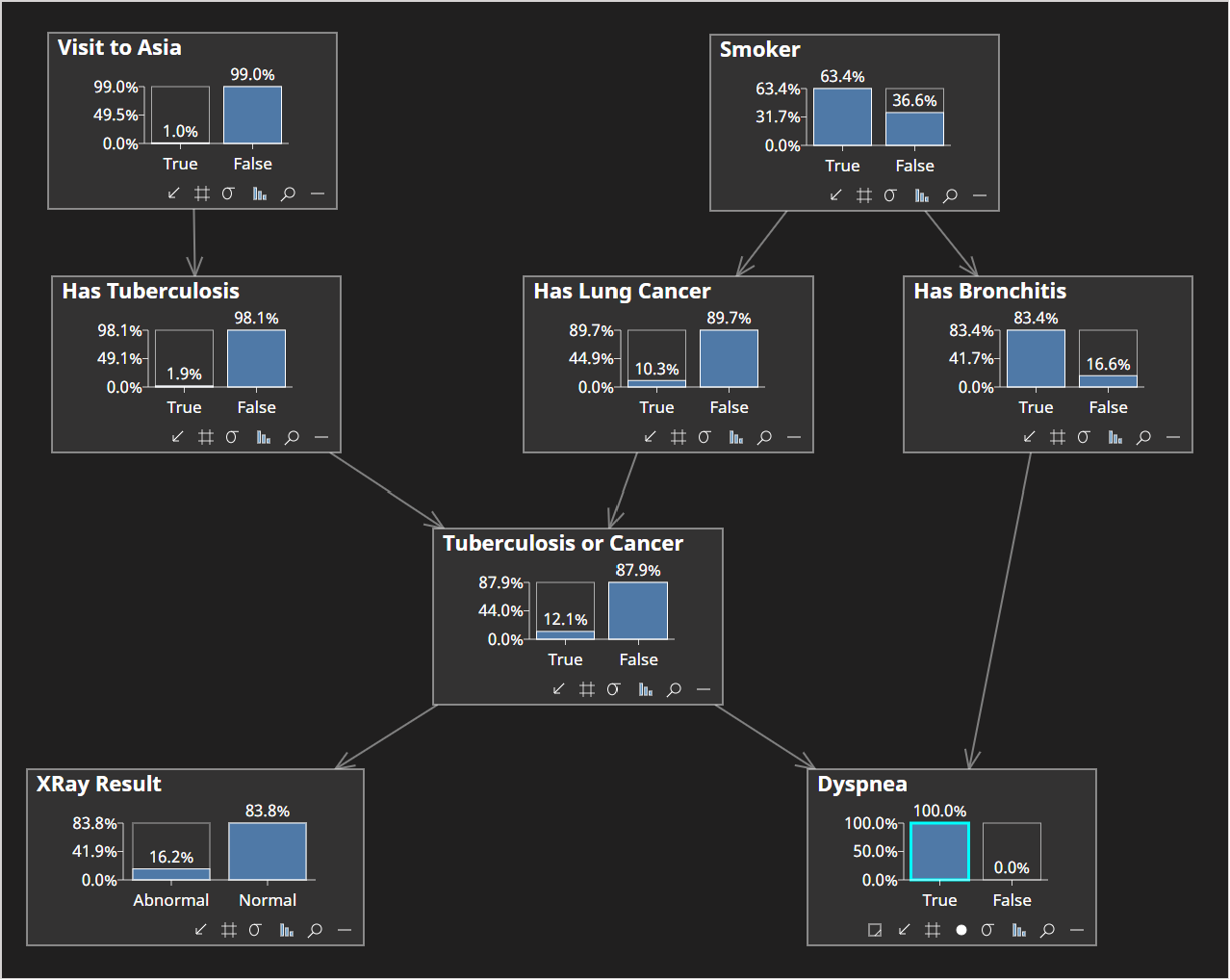Value of Information Tutorial
In this tutorial we will use the Asia sample network, which is included with Bayes Server, to demonstrate how to use the Value of Information tool.
A Value of Information analysis considers a Target variable of interest, sometimes also referred to as the Hypothesis variable.
Bayes Server supports Value of Information with both discrete and continuous variables (as well as decision graphs and time series), but we consider just the discrete case in this tutorial.
In this first example, we are interested to know whether someone has bronchitis or not. The Value of Information tool will help guide us, by using a greedy target-driven approach that helps us choose the next unobserved variable that will reduce the uncertainty of Has Bronchitis the most (if at all).
- Open the Asia sample network included with Bayes Server, either from the Start Page or from the File menu, click Open.
The Asia network with no evidence set should look like this...

- Inspect P(Has Bronchitis) when no evidence is set.
Confirm it is as follows.
| Has Bronchitis=True | Has Bronchitis=False |
|---|---|
| 0.45 | 0.55 |
- Click on Has Bronchitis to select the node, without setting evidence on it.
- From the Analyze menu click VOI which is short for Value of Information.
The Value of Information dialog is displayed.
Confirm that Has Bronchitis has automatically been selected as the Target (Hypothesis) variable (since it was selected when we launched the VOI tool). If not, select it in the drop down.
Test variables should include the following variables:
- Dyspnea
- Smoker
- XRay Result
- Visit to Asia
The options should look as follows:

- Click Run.
The result should look as follows:

- Towards the top of the dialog, check that the Target Entropy is 0.688.
Entropy often denoted tells us how uncertain we are about the state of a variable. Value of Information seeks the next variable to observe, that will reduce this value the most.
Entropy:
Hence:
Mutual information is the reduction in Entropy in Has Bronchitis that is likely to be achieved if Dyspnea is observed.
Verify that the next best variable to observe is Dyspnea with Mutual Information = 0.251.
Also verify that the Mutual information for Visit to Asia is zero. This means that Visit to Asia is most likely independent of Has Bronchitis given the current evidence. We will check this in a later step using the D-separation tool.
Close the VOI dialog.
Now try setting evidence on Dyspnea and verify that it does indeed significantly reduce the uncertainty in the state of Has Bronchitis.
From the Analyze menu click D-Separation -> D-Separation display.
In the Node selector dialog, select Has Bronchitis and click OK.
The network display should now look as follows, confirming that Visit to Asia and also Has Tuberculosis are independent of Has Bronchitis given the current evidence.

- From the Analyze menu click D-Separation -> D-Separation display.
- In the Node selector dialog, de-select Has Bronchitis and click OK.
Now we are going to observe Dyspnea and continue our analysis (diagnosis). In this case we observe the patient to suffer from Dyspnea.
- In the display set Dyspnea = True by click the bar in the node labelled True.
The network should now look as follows:

Click on Has Bronchitis to select the node, without setting evidence on it.
From the Analyze menu click VOI which is short for Value of Information.
Confirm that Has Bronchitis has automatically been selected as the Target (Hypothesis) variable (since it was selected when we launched the VOI tool). If not, select it in the drop down.
Test variables should include the following variables:
- Smoker
- XRay Result
- Visit to Asia
The options should look as follows:

- Click Run.
The result should look as follows:

- Towards the top of the dialog, check that the Target Entropy is 0.45.
Verify that the next best variable to observe is X-Ray Result with Mutual Information = 0.014.
Close the VOI dialog.
We may or may not choose to perform an X-Ray given the lower reduction in uncertainty at this point. In general however, we could continue to observe additional variables by performing additional VOI analyses.